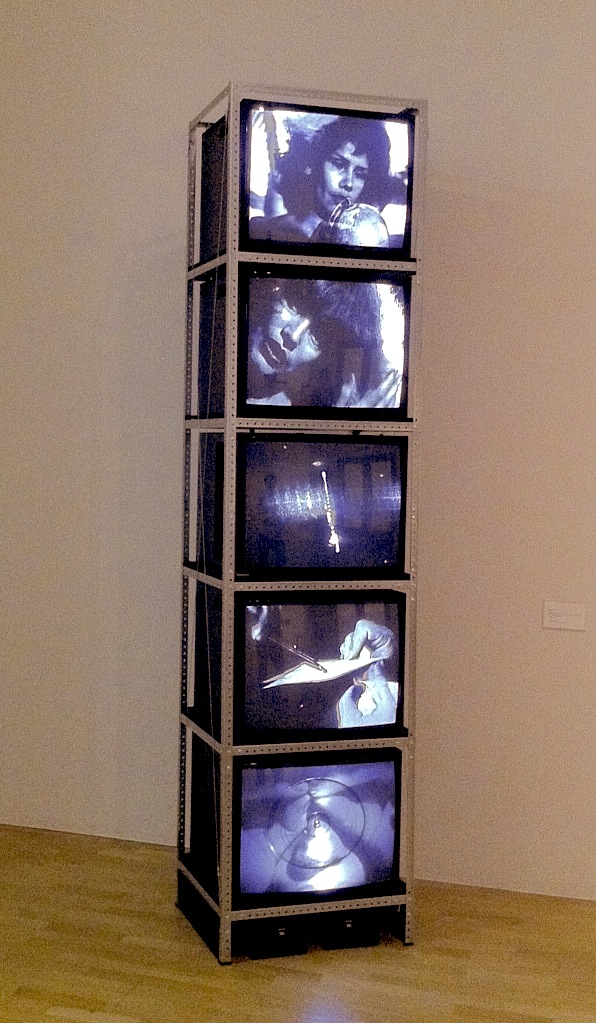“In another time I guess I would have been content with filming girls and cats. But you don’t choose your time.” Chris Marker
Judging by some of the works displayed at his first UK retrospective, not to mention the title of the exhibition itself, Chris Marker really loved felines. I think the French artist and filmmaker would probably have looked with a sympathetic eye at one of the most enduring Internet trends, cat memes.
On until 22 June at the Whitechapel Gallery, “Chris Marker: A Grin Without a Cat” is full of references to cats. They range from the director’s own words, which open this post, to some of his most iconic works, such as Chats perchés (The Case of The Grinning Cat) [2004] or Ouvroir. The Movie [2010], a three-dimensional archipelago created on Second Life and presented by Marker’s avatar, the cat Guillaume-en-Egypte.
Although he is internationally known for a particular mix of documentary and personal reflections, the so-called “essay-films”, Marker was a true pioneer of new media and installation art. He was also politically involved and his commitment to recording historical events is clearly shown here. The exhibition covers multiple artistic formats within four key themes recurring throughout his career: “The Museum”, “Travelogues”, “Films and memory” and “War and Revolution”.
The artist passed away in 2012 and his interest in different artistic mediums is pretty evident in the exhibition. The Gallery managed to gather together a wide range of works spanning the 1960s to early 2000s. They include photographs from the Staring Back Series [1952-2006], documentaries like Le fond de l’air est rouge (A Grin Without a Cat) [1977], not to mention several videos and mixed media installations, such as the multimedia work Quand le Siècle a pris forme (Guerre et Révolution) – When The Century Took Shape (War and Revolution) [1978] and the five channel video installations Silent Movie [1995].
“Memories of Things to Come: The Future-Past of Film” illustrates Marker’s idea of cinema as a time machine, a repository of memory images and a source of temporal paradoxes. To me this section is the heart of the exhibition, because it features the “photo-roman” La Jetée (The Pier) [1962]. Probably Marker’s most famous work, it is best known for inspiring Terry Gilliam’s film 12 Monkeys [1995].
La Jetée is screened at the Gallery in a rare version with an opening sequence that is different from the definitive cut above. The related workbook describing the film in the form of a “photo-novel”, and La Jetée: Ciné-Roman, published by Zone Books/MIT Press in 2008, are displayed alongside and contribute to a better contextualisation of Marker’s masterpiece, which finds an ideal and intimate environment in this section of the Gallery.
Walking through the exhibition is a peculiar experience. Viewers are surrounded by a variety of media, fragments of films, cartoons, found footage, computer-driven stories and advertisements, electronic noises, and musical scores. Images and commentaries overlap each other: the Cuban Revolution, the Vietnam war, Japanese temples devoted to cats, online digital worlds, crowded streets and silent temples, the reality of everyday life and the exotic lure of unknown rituals.
Step by step visitors become familiar with Marker’s eclectic yet recognisable style, ranging from the massive 150-minute documentary Le joli Mai (The Merry Month of May) [1962] to Zapping Zone (Proposals for an Imaginary Television) [1990-1994]. At the same time, viewers also become the active agents of an ongoing remix, using their own senses to explore the mind of one of the sharpest and most elusive filmmakers of 20th Century.
[Photos taken at The Photographers’ Gallery, except for Zapping Zone (Proposals for an Imaginary Television) (1990-1994) video still production du Service Nouveaux Médias, CGP © Coll. Centre Pompidou, photo: Georges Meguerdithcian].




